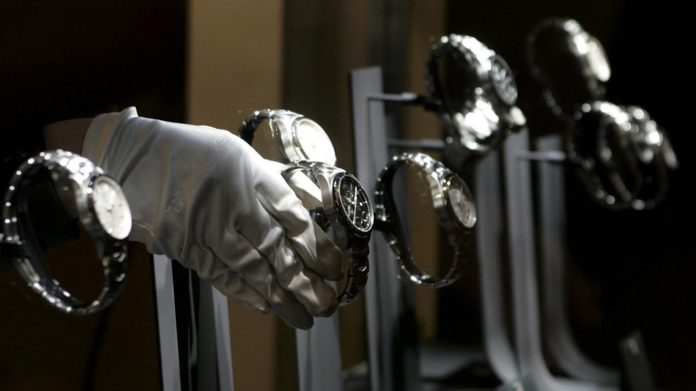Apple’s New Hire Suggests More Than One iWatch Is in the Works

What does Apple know about selling smartwatches that Google and Samsung don’t? Whatever it is, it’s probably locked in the mind of Patrick Pruniaux, TAG Heuer’s former vice-president of sales and retail, whom Apple poached late last week for unknown reasons — except the reasons are incredibly obvious to anyone who’s been paying attention.
Apple is poised to enter a new category later this year with some kind of wearable device, most likely a smartwatch. The company has been aggressively hiring people for over a year to develop the so-called iWatch; Pruniaux is just the latest recruit.
There’s something different about this one, though. Most previous iWatch hires have emphasized the device’s rumored health and fitness features. While TAG Heuer is sportier than other luxury-watch brands, it is still about fashion, not innovative sensor technology.
With a luxury-watch executive on board, it’s clear Apple is thinking way beyond the Apple Store when it comes to selling the iWatch. Pruniaux brings to the table a knowledge of the wristwatch market and distribution channels. Put simply, he knows how to sell watches to people who want to buy watches.
“My guess is they’ve hired him to provide relationships, and to get an in to the kind of retail partners that they need to sell this thing in large numbers — whatever this thing ends up being,” said Jan Dawson, a mobile analyst. “All the hires Apple’s been making seem to be coming from that fashion heritage, rather than that consumer-electronics heritage. And there are fundamentally different retail channels involved with that.”
While that seems obvious, no smartwatch manufacturer has taken this approach yet. Samsung, LG and others have so far been content to sell their smartwatches in traditional ways: either at electronics stores or through wireless carriers. (The much-admired Moto 360 — probably the most stylish smartwatch currently on the market — may deviate from this script when it becomes available this summer, but so far there are no indications of that.)
That electronics-store approach has some merit. The devices will find utility-focused customers who want a smartwatch for its various features, such as notifications and sensor data — probably someone who gave up wearing a watch shortly after they got their first cellphone. Targeting traditional electronics retail stores locks up the gadget customer.
There’s another kind of customer for smartwatches, though, and that’s the person who goes out to buy a wristwatch specifically. These folks are buying a fashion statement and status symbol as much as a timepiece. No smartwatch vendor has made a play for these customers yet, probably because the current crop of smartwatches look big and ugly in comparison to your average Swiss-made analog model.
“This could indicate that Apple will sell at a higher price than other smartwatches,” said Matthew Morse, founding publisher of watch lifestyle magazine Revolution. “At $500, Torneau [a high-end watch retailer] could carry it. And that would give them the opportunity to capitalize on known watch avenues. Many watch guys are gadget guys.”
Will the iWatch be worthy of sitting in the same display case as watches from Michael Kors or Movado? Pruniaux’s hiring suggests it might, although that kind of distribution doesn’t quite sync up a sensor-laden sports and fitness-oriented device — basically everything the iWatch is rumored to be.
“The easiest thing for them to do is in the health and fitness space, but it’s more of a limited opportunity,” said Van Baker, vice-president and mobile research director at Gartner. “How many people are that health focused? A smartwatch might have broader appeal if they can get the right form factor.”
If rumors about the iWatch’s abilities are accurate (and that’s still a leap at this point), there are two ways to resolve this disconnect:
-
The message behind the iWatch will be that it’s a high-tech fashion statement that just happens to record fitness data
-
There will be two (or even more) iWatches, the first a sleek gadget focused on fitness, and a second, probably coming afterward, that’s a stylish smartwatch more like the Moto 360
“My guess is Apple is going to release a series of devices,” Dawson said. “They’ll be wearable in different ways. Maybe a wristband, maybe something you clip on your clothes or even headphones. Each would gather data, and feed it back to you in a way that makes sense for the device.”
While two iWatches flies in the face of Apple’s typical “one size fits all” product strategy, it actually makes the most sense. Watches — all wearables, really — never have a singular design that appeals to everyone. Even if you take into account gender alone, tastes diverge wildly.
Whether there are two iWatches or just one, Apple’s apparent plan of involving watch retailers could be the most innovative thing about its new gadget. While it remains to be seen whether wristwatch aficionados will laugh or ogle at the iWatch, at least Apple’s taking a shot at reaching them — something other smartwatch makers, in their rush to market, apparently didn’t consider in time.
Have something to add to this story? Share it in the comments.
